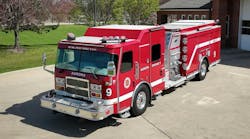If your department is in the process of replacing an existing aerial device, it would be a great idea to break out a tape measure and record the wheelbase, overall length and overall height of the present rig. This will provide the committee with a barometer of the critical measurements when evaluating new vehicles.
Any fire department buying a new aerial apparatus should measure the available clearance through the overhead door and the usable depth in the apparatus bay where the rig will be stored. More than one fire department has been surprised when it took delivery of its new 100-foot rear-mount tower ladder, only to find out that the rig didn’t fit into the station because it was too high. Don’t take the word of another member in the fire company about how big the bay is; actually measure the door opening and, if needed, place the ladder truck into the door opening to determine the exact clearance that you have in the apparatus bay.
The maximum allowable dimensions for the apparatus must be clearly spelled out in your specifications in order to allow prospective bidders to prepare an adequate bid response. Completing the Apparatus Purchasing Specification Form in Annex B of the National Fire Protection Association (NFPA) 1901 Standard would be a good start for any apparatus committee to undertake prior to setting out with the specification process.
First, let’s look at midship-mounted aerial devices and what design features they offer. A midship aerial device provides a lower overall travel height for those departments that have reduced-height bay doors, bridges or underpasses that would restrict travel. By varying the position of the turntable on the chassis frame, the overall travel height of the apparatus can be modified to meet the individual needs of the fire department.
As the overall height of the vehicle gets lower, the space for ground ladder storage and the usable compartment space are reduced accordingly. The NPFA requirement for enclosed compartment space on an aerial ladder or quint is 40 cubic feet with a payload capacity of 2,500 pounds. Unfortunately, many ladder trucks are designed to meet these minimum standards, but have little or no usable space to accommodate the needed equipment and ground ladder complement.
Midship aerial devices are generally easier to spot and position on the fireground, as the center-mounted turntable allows the operator to locate the center of the turntable with the midpoint of the structure. Units that have raised-roof cabs can inhibit the ability of the aerial device to operate at low angles when a device is working off the front of the apparatus. This is particularly important with mid-mounted tower ladders where it may be impossible to operate the tower at angles below 30 to 35 degrees.
Your fire department may be limited to a midship aerial design due to overall height limitations within the community; if so, the committee should work diligently to develop specifications that provide the maximum number of components that will benefit the department. Midship aerial and tower ladder devices offer superior scrub-area coverage on buildings when compared to rear-mounted apparatus. Scrub area is defined as that part of the tower ladder bucket or the tip of the aerial device that can touch the building line. The better the scrub area of a particular aerial device, the more use your department will get on the fireground. Better scrub area is a direct result of apparatus positioning on the fireground, apparatus design and what vendor you choose to build your aerial device. Design features such as outrigger placement, body heights and ground ladder arrangement are much more user friendly than rear-mounted devices. The fire department can often benefit from the input and perspective of an apparatus architect in this regard.
The discussion of rear-mounted aerial devices needs to be broken down between aerial ladders versus aerial towers. These units generally produce a higher overall height vehicle; however, with the use of low-profile cabs, these units can sometimes still fit into an 11-foot bay door. Rear-mount aerial ladder trucks can be built on short wheelbase chassis to make the units more maneuverable in tight locations. For a given specified overall height, the body configuration on a rear-mount unit can offer the department more options with respect to compartment dimensions and ground ladder storage. These ladders can be mounted both within the body and carried in a side-stack arrangement, in addition to carrying a roof ladder within the fly section of the aerial device. Where the NFPA 1901 standard only calls for five ladders totaling 115 feet, rear-mount aerial ladder units can be effectively designed to carry upwards of 250 feet of ground ladders in various configurations. Purchasing a rear-mounted aerial ladder could prove to be a big benefit for your department.
Rear-mounted aerial tower units have become the “unit de jour” in many departments. Those departments that were not restricted by the size of the apparatus bay or other hazards rapidly acquired these types of devices, as they were the largest and tallest rigs available. While this type of aerial tower offers good vertical and horizontal reach, the effective scrub area is limited by the design of the turntable and height from the ground, together with the elevation limits of the hydraulic cylinders. The angle of departure off the side of the apparatus is much greater for a rear-mounted tower ladder versus a mid-mounted tower ladder; this cuts the scrub area of the rear-mounted tower ladder significantly.
If your department has not previously operated a rear-mount aerial tower, consider that a significant amount of driver and operator training will be required prior to placing the unit in service, as the physical size of the vehicle and the front overhang of the platform may necessitate some changes in response patterns and procedures. The outrigger stance for these devices are generally wider than other types of aerial equipment and this also must be considered when planning for the deployment of these rigs in tight situations. Given everything else being equal, there are far more advantages in choosing a mid-mounted tower ladder over a rear-mounted tower ladder.
It is almost as if the apparatus committee is afraid or intimidated. Why did you buy that 100-foot ladder? It is the longest tower ladder offered and no one can ever accuse the apparatus committee of buying a ladder that came up short on the fireground. Why did the apparatus committee put a bucket on the end of the ladder? So that no one could ever accuse the apparatus committee of providing a rig where someone might fall off the ladder; they can now ride in the bucket. In fact, many firefighters have told us that the reason they bought a tower ladder instead of an aerial ladder is that everyone would rather ride in the bucket rather than climb the ladder. Riding in the bucket has never been a good reason to expend an additional $100,000 in taxpayer money. Although both a bucket and a 100-foot reach are nice to have on an aerial device, they simply may not be needed.
In the past six articles in “The Apparatus Architect” series, we have taken you through some of the questions, concepts, considerations and pitfalls that your apparatus committee should evaluate during the purchasing process for your new ladder company unit. It is important to remember that decisions that you make at this point will impact the department training and operations for many years to come. Remember the slogan: “An educated consumer is our best customer.” Work toward designing a practical, useful and most importantly safe ladder truck and let’s make sure that “everybody goes home” after the run. When in doubt, get outside help – hire an apparatus architect.
In the next installment of “The Apparatus Architect,” we will begin our discussion on special-service units and how they can complement our operations at accident and fireground scenes.
Tom Shand, a Firehouse® contributing editor, is a 33-year veteran of the fire service and works with Michael Wilbur at Emergency Vehicle Response, consulting on a variety of fire apparatus and fire department master-planning issues. He is employed by American LaFrance and is assigned to the Hamburg, NY, facility.Michael Wilbur, a Firehouse® contributing editor, is a lieutenant in the New York City Fire Department, assigned to Ladder Company 27 in the Bronx, and has served for the past five years on the FDNY Apparatus Purchasing Committee. He has consulted on a variety of apparatus related issues throughout the country. For further information access his website at www.emergencyvehicleresponse.com.








